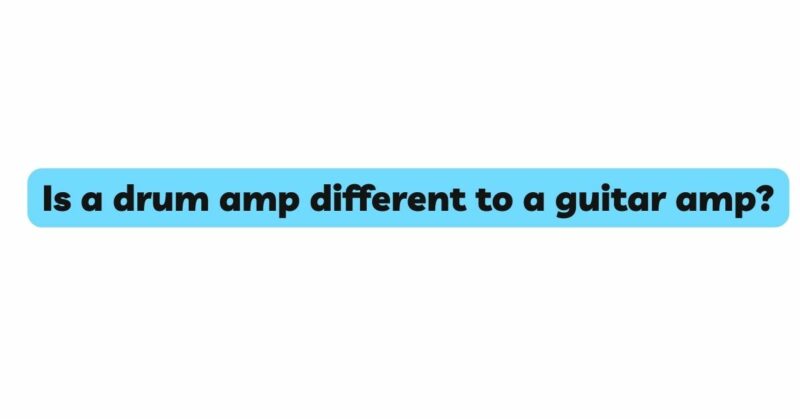In the symphony of musical instruments, each component contributes a unique timbre that shapes the overall sonic landscape. Drums, with their rhythmic beats, and guitars, with their melodic lines, are two fundamental elements of music. As discussions center around amplification, a pertinent question arises: Is a drum amp different from a guitar amp? This article delves into the intricacies of drum amps and guitar amps, exploring their differences, similarities, and the factors that define their roles in the world of musical amplification.
The Essence of Drum Amplifiers
To understand the divergence between drum amps and guitar amps, it’s crucial to fathom the essence of each. A drum amplifier, often referred to as a drum monitor or drum amp, serves the purpose of projecting the sound of percussion instruments, including drums and cymbals. These instruments produce a wide spectrum of frequencies, ranging from thunderous lows to sharp highs, requiring amplification that accurately represents their complex sonic characteristics.
Drum amps are meticulously designed to capture the intricacies of drum sounds. They emphasize clarity, definition, and even dispersion of sound across a stage or performance space. Drummers rely on these amplifiers to hear their instruments clearly amidst the cacophony of live performances. The intention is to provide an accurate representation of the percussion’s nuances, aiding drummers in maintaining precise timing and rhythm.
The Nature of Guitar Amplifiers
In contrast, a guitar amplifier, or guitar amp, is tailored to the tonal intricacies of electric guitars. Electric guitars operate within mid- to high-frequency ranges, focusing on expressive melodies and harmonies. Guitar amps are engineered to accentuate the mid-range frequencies, ensuring that the guitar’s tonal qualities are projected effectively.
Guitar amplifiers often incorporate features like distortion, reverb, and various effects that enhance the unique sonic characteristics of electric guitars. These features enable guitarists to shape their sound and create distinct tonal identities. Guitar amps come in various sizes and configurations to cater to different genres, playing styles, and performance venues.
Differences in Frequency Range
One of the most prominent distinctions between drum amps and guitar amps lies in the frequency range they address. Drum amps are equipped to handle the wide spectrum of frequencies produced by percussion instruments. This range spans from the deep lows of bass drums to the shimmering highs of cymbals. Drum amps must accurately reproduce these frequencies to provide drummers with an authentic representation of their instrument’s sound.
On the other hand, guitar amps are optimized to focus on mid-range frequencies that highlight the expressive qualities of electric guitars. While they cover a range that typically extends from low mids to upper mids, the emphasis on these frequencies is pivotal in allowing electric guitars to cut through the mix and maintain their presence in a musical arrangement.
Power and Speaker Configuration
The power and speaker configuration of drum amps and guitar amps play a crucial role in shaping their functions. Drum amps require a significant amount of power to effectively project the dynamic and varied sounds of percussion instruments. The complex interactions between drum heads, cymbals, and other components necessitate ample power to ensure clarity and definition in the overall drum sound.
Drum amps often feature a combination of full-range speakers and tweeters to accurately reproduce the diverse frequencies of drums and cymbals. This configuration enables drummers to hear the entire tonal spectrum of their kit, aiding in precise playing and rhythm maintenance.
Addressing the Complexity of Percussion
Drums, being inherently complex instruments, pose a unique challenge for amplification. The drum kit comprises various components, each producing distinct frequencies and harmonics. The task of a drum amp is to provide balanced and accurate representation, preserving the integrity of each drum’s sound.
In contrast, guitar amplifiers cater to the sonic qualities of electric guitars, which tend to produce fewer simultaneous frequencies compared to a full drum kit. Guitar amps focus on projecting the expressive nature of melodies and harmonies, allowing guitarists to sculpt their sound with effects and dynamics.
Conclusion
In summary, the distinction between drum amps and guitar amps is rooted in the inherent characteristics of the instruments they serve. Drum amps are meticulously designed to capture the multifaceted sounds of drums and cymbals, emphasizing clarity, definition, and even dispersion. They accommodate the wide frequency range produced by percussion instruments, aiding drummers in maintaining rhythm and timing in live performances.
Guitar amps, conversely, are tailored to accentuate the mid-range frequencies that showcase the melodic and harmonic qualities of electric guitars. These amps often feature effects and controls that allow guitarists to shape their sound and create unique tonal signatures.
While there may be instances where a drum amp could potentially be used for amplifying electric guitars or vice versa, the ultimate goal should be to harness the full potential of each instrument’s sonic characteristics. By investing in dedicated amplification tailored to the specific needs of drums or guitars, musicians can create an immersive and authentic auditory experience that resonates deeply within the music they create.

